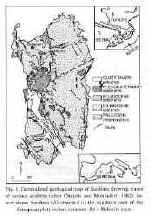Sedimentary Geology, 76 (1992), 63-78
SILICICLASTIC-CARBONATE SEQUENCES OF MIOCENE GRABENS OF NORTHERN SARDINIA,
WESTERN MEDITERRANEAN SEA
I.P. MARTINI1, G. OGGIANO2 and R. MAZZEI3
1Department of Land Resource Science, University of Guelph, Guelph,
Ont. N1G 2Wl, Canada
2Istituto Policattedra di Scienze Geologico-Mineralogiche, Universitti di
Sassari, Corso Angioj 10, Sassari 07100, Italy
¡¡
 The small crustal block of Sardinia Island (western Mediterranean) underwent
major rifting events during Oligocene-Early Miocene (Aquitanian), Early
Burdigalian, and Plio-Pleistocene times. Sedimentation in the resulting
extensional and transtensional basins was affected by both local tectonic and
worldwide sea-level changes. The mixed siliciclastic-carbonate sequences which
developed, are readily comparable with those predicted by sequence stratigraphy.
This paper focuses on the post-volcanic, Uppermost Burdigalian to Lower
Messinian (?) sedimentation at the confluence between a main N-S trending basin
and a secondary SW-NE trending graben, in northern Sardinia. Silty marlstones of
Late Burdigalian-Early Langhian age characterize the central part of the main
basin, whereas variable siliciclastic and carbonate sequences affected by up to
three major transgression and regression cycles developed at its margins and at
the confluence with the smaller graben. Differential movements along the main
boundary fault led to rotation of blocks that localized narrow, elongated
offshore algal carbonate platforms. Low sea-level stand led to deep erosion
(type 2 sequence boundary) of these carbonates and to the formation of
siliciclastic sandy lowstand wedges. High sea-level stand led to
re-establishment of algal platforms at the shelf margin, which were bounded
farther inland by siliciclastic-carbonate mixed parasequences. Although it is
not possible to date directly every stratigraphic unit, local sequences are well
structured and can be tentatively correlated with reported worldwide
transgressive-regressive events.
The small crustal block of Sardinia Island (western Mediterranean) underwent
major rifting events during Oligocene-Early Miocene (Aquitanian), Early
Burdigalian, and Plio-Pleistocene times. Sedimentation in the resulting
extensional and transtensional basins was affected by both local tectonic and
worldwide sea-level changes. The mixed siliciclastic-carbonate sequences which
developed, are readily comparable with those predicted by sequence stratigraphy.
This paper focuses on the post-volcanic, Uppermost Burdigalian to Lower
Messinian (?) sedimentation at the confluence between a main N-S trending basin
and a secondary SW-NE trending graben, in northern Sardinia. Silty marlstones of
Late Burdigalian-Early Langhian age characterize the central part of the main
basin, whereas variable siliciclastic and carbonate sequences affected by up to
three major transgression and regression cycles developed at its margins and at
the confluence with the smaller graben. Differential movements along the main
boundary fault led to rotation of blocks that localized narrow, elongated
offshore algal carbonate platforms. Low sea-level stand led to deep erosion
(type 2 sequence boundary) of these carbonates and to the formation of
siliciclastic sandy lowstand wedges. High sea-level stand led to
re-establishment of algal platforms at the shelf margin, which were bounded
farther inland by siliciclastic-carbonate mixed parasequences. Although it is
not possible to date directly every stratigraphic unit, local sequences are well
structured and can be tentatively correlated with reported worldwide
transgressive-regressive events.